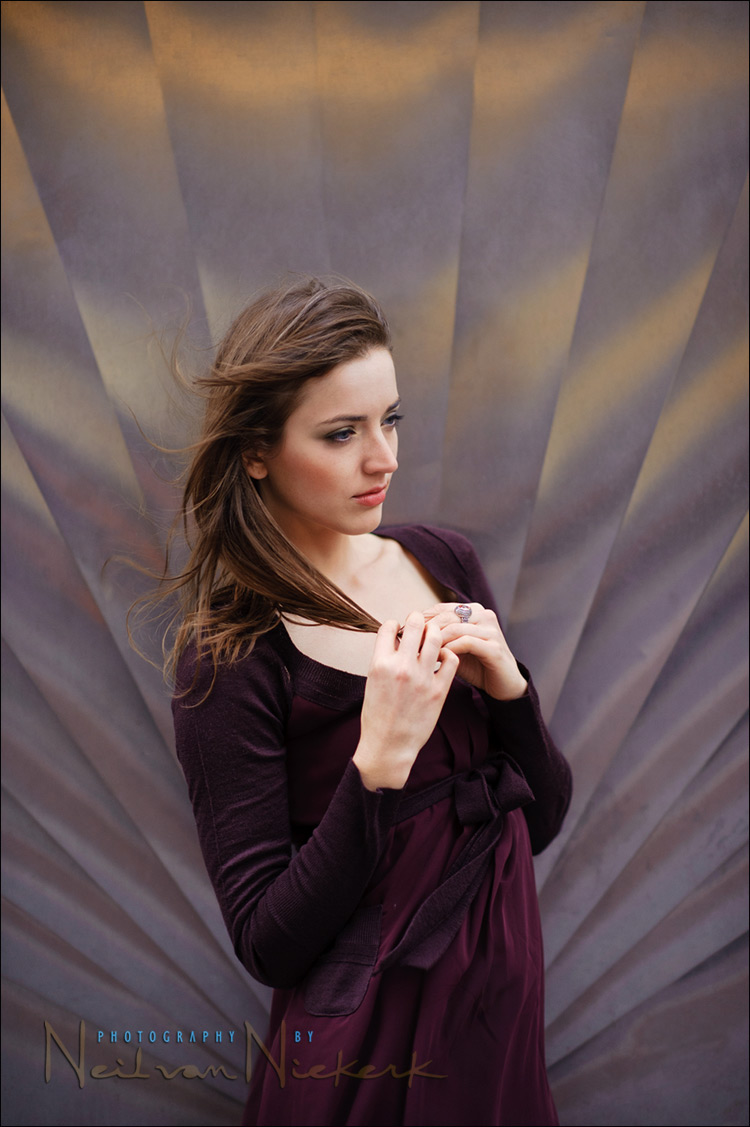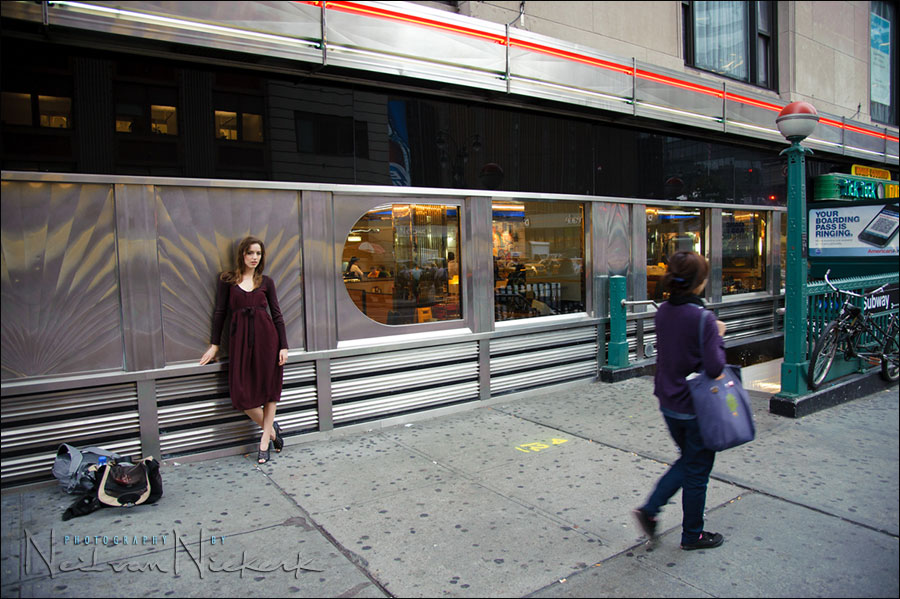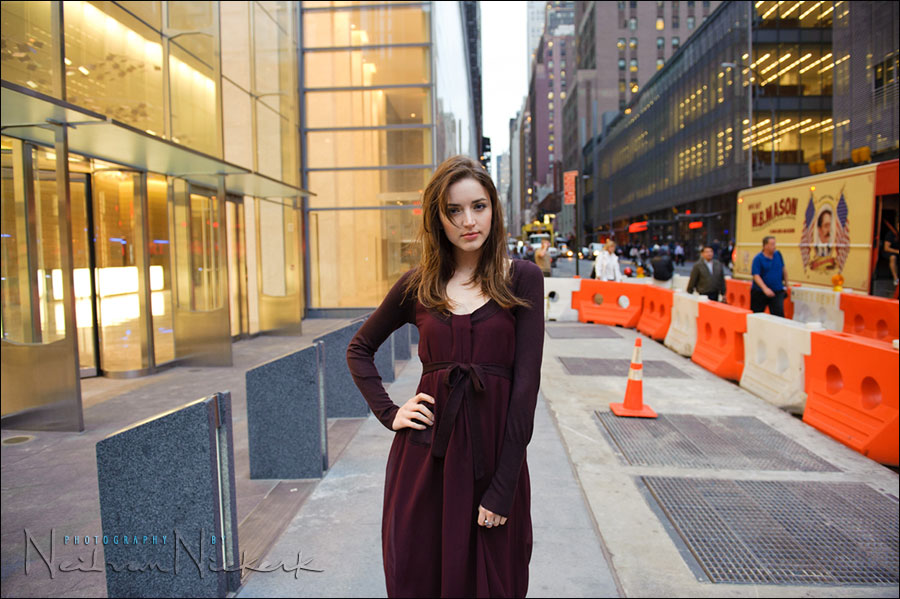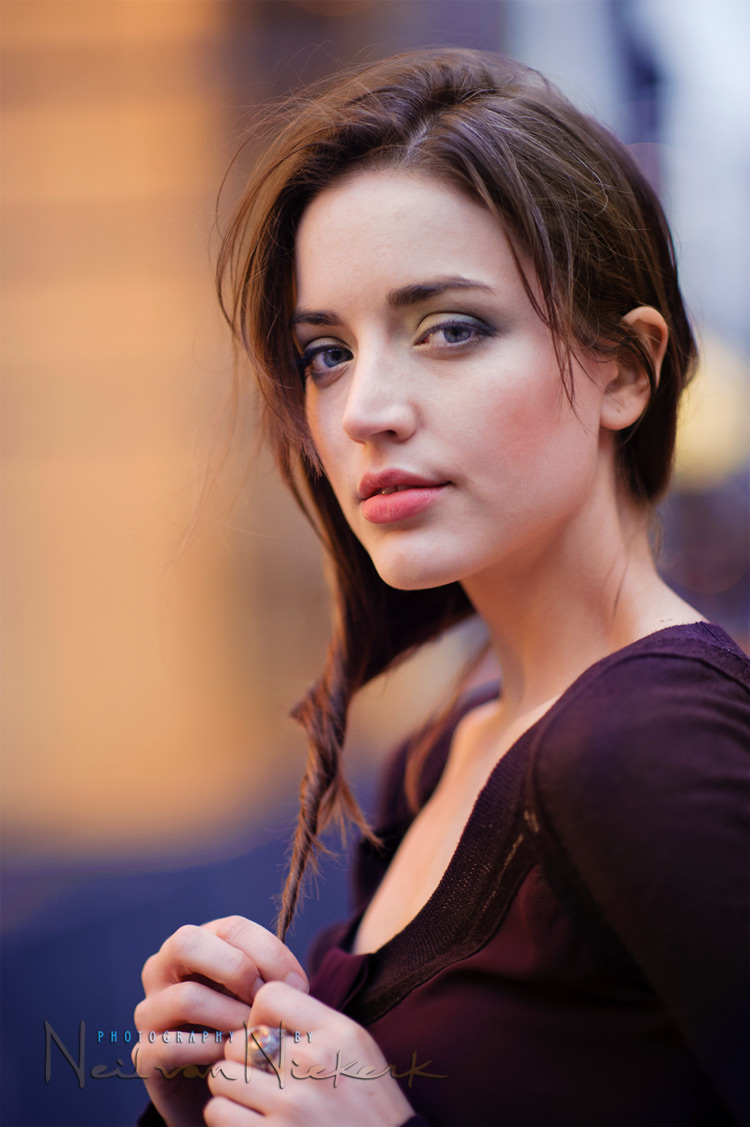
creating a background with narrow depth-of-field & great bokeh
Shooting images for the review of the Nikon 85mm f1.4G AF-S lens, it struck me how truly superb this lens is. It improves on the legendary Nikon 85mm f1.4 AF-D lens in some key areas. (For me the updated lens was an immediate upgrade.)
But ultimately, you could get similarly beautiful images with any short portrait lens that gives you a very narrow depth-of-field AND has great bokeh. (Just to reinforce that again .. narrow DoF and bokeh are not the same thing. But I digress.) So, whether you’re shooting with a Nikon 85mm f1.4 lens (B&H), or the Canon 85mm f1.2 (B&H), or Canon 85mm f1.8 (B&H) … these images are easily attainable. It is more about the technique and thought-process and approach, than any specific piece of equipment. However, you do need photo equipment that enables you to achieve what you want to, technically and stylistically.
So walking around with Anelisa in New York, looking for great backgrounds I saw this fantastic Art Deco styled exterior of a diner. And I knew that with the various colors and shadings in the late afternoon, it would give beautifully colored reflections at various angles. Here is the pull-back shot …

The approach is simple, and exactly what thousands of photographers have done before … find a great background to place someone in front of. It is a simple approach, and usually works very well. Choosing a shallow depth of field here wouldn’t really affect the final photograph since she is so close to the background. But what I wanted to show with the rest of this post, is how we can create a varied background when shooting with a shallow depth-of-field and a lens with great bokeh.
Now where these wide-aperture telephoto lenses excel, is in melting away any background that is a distance away from your subject. In fact it seems like you could place your subject pretty much anywhere (where you have great light), and allow the background to disappear into mush.
From this exact spot …

… we were able to pull out a series of gorgeous portraits. I really liked this one. It’s just the available light again.

The background, when in focus, is truly random and ugly. But, as a defocused background, it looks great … however, it isn’t random. It is still specific. I moved my position until I had her framed the way I wanted to, in relation to the out-of-focus colored areas. This is still very consistent with my approach in achieving effective on-location portraits. Similarly, the way I positioned Anelisa isn’t random either, but very specific in relation to the available light. In this way, I created the background with a combination of shallow depth of field, and a lens with great bokeh. A do-everything zoom is just not going to get you there if you want to achieve this kind of look.
From here on we went to Times Square. But Times Square is so colorful that it becomes really easy to pull these kinds of shots out with an 85mm prime lens used at a wide aperture. SO easy it seemed like cheating in comparison to the photo above.
The final point to this posting, is that there is a consistent technique here. A way of seeing and working … enabled by using equipment of a certain quality.
Camera settings:
image at the top: 1/160 @ f1.8 @ 800 ISO
image at bottom: 1/250 @ f1.4 @ 800 ISO
Related articles
- How to get a blurred background in photos
- Bokeh – quality of lens blur
- Using lens bokeh as a design element
- Bokeh vs shallow depth-of-field (DoF)
Neil,
Very nice composition in the first one. Because the background is an Art Deco seashell, the first thing that came to my mind is “The Birth of Venus” by Sandro Botticelli (circa 1486).
Also, the last photo can be similarly achieved by the 70-200mm f2.8, as shown here by Neil: https://neilvn.com/tangents/photography-direction-light-change-background/
Obviously, f1.4 is two stops larger than f2.8, so the optics are not the exactly the same, but the narrow depth of field and bokeh still apply.
I always appreciate your pull back shots that show what you were dealing with or what it is in the background.
Neil, everyone always states that shooting wide open on lens are always soft. I.E., the nikon 85 1.4 while shooting at 1.4. They say when stopped up the optics become sharper. How do you feel about these saying, do you believe this also, then I asked why buy a lens of 1.8/1.4/2.8 if you do not get sharp photos wide open. Just curious, because I do value your thoughts after all the insights that you give us. Thanks Jerry.
Neil,
another great post, thank you. It’s a good reminder to me to leave the flash off occasionally. I noticed at the beginning of the post you mentioned the Canon 85mm f/1.8 but not the Nikon 85mm f/1.8. Was this intentional or an over site? You have spoken positively of it in the past. If you did not guess, I have the Nikon 85mm f/1.8 :-D
Thanks
@Jerry
While is true that most lenses at the widest apertures exhibit some spherical and chromatic aberration causing softer image focus, this is usualy more common in consumer grade lenses. Professional grade lenses have superior optical quality and usually additional elements to correct most of these defects allowing for sharper image and better color/contrast at the widest apertures. I routinely shoot “full open” with several of my professional lenses with very sharp results. On all lenses, stopping down a little (if possible) can lift the quality of the image by reducing these optical defects. You should conduct controlled shooting tests of your lenses to find the minimum amount of aperture reduction needed to obtain a noticiable increase in image quality ~ although common wisdom is 1-2 stops, my experience is each camera/lens combination has it’s own sweet spot and it pays for you to determine that before hand.
One issue that can contribute to poor results while shooting wide open is an improper lens/body match leading to lack of focusing accuracy. Checking the lenses under controlled conditions to determine if the system is focusing accurately is essential to obtaining accurate and repeatable results. Thorough knowledge of your equipment is a fundamental part of the art and craft of photography.
Finally, while shooting wide open (with telephoto lenses in particular) you neen to be aware of the limited depth-of-field available to you. Lack of understanding or DOF control by inexperienced photographers is the number one cause that I can see of failure to get good images out of these lenses. Once focus is achieved, is not only important to maintain distance to subject constant, but also to understand that if you recompose with this lenses after “locking” focus, you are likely to move the focal plane by altering the angle of the sensor in relation to your subject enough to loose sharpness on the areas of interest. I hear many photographers blaming the equipment when in this situation is the photographer that needs to learn/understand proper technique for shallow depth of field photography.
I’m in Love with Anelisa.
Hi Neil
“Once focus is achieved, is not only important to maintain distance to subject constant, but also to understand that if you recompose with this lenses after “locking” focus, you are likely to move the focal plane by altering the angle of the sensor in relation to your subject enough to loose sharpness on the areas of interest.”
Thank you for this very valuable tip and I now know this has been my long standing problem when using my Nikon 85mm 1.4. I tend to compose with the subject off centre and be ‘lazy’ in using the already selected focus point and then recompose. I’ve always been mindful of not moving in relation to the camera to subject distance at 1.4 but often wondered if it was the recomposing that was causing my hit and miss with this lens. You’ve answered a doubt I had in relation to the recomposition being enough to knock off the sharpness due to such shallow DOF.
Thanks
Nigel
Thank you for taking the time out to re-inforce again that beautiful photography doesn’t have to be about van loads of equipment, and also that the simplicity is there in front of us. All those fussy backgrounds we suffer from can almost always be eradicated by isolating and simple repositioning of the model as you show. Good stuff!
Always great… Thanks Neil
With the bottom image, can you explain a few things? I know I would have had the rear eye out of focus.
Do you recall your approximate lens to subject distance?
And, which eye did you focus on? From what I’m reading I guess you’re not focusing with center spot on eye and recomposing…. correct?
Wide open portraits at 1.4 or 1.8 are frustrating for me because I can’t seem to keep the entire face in focus.
Is that the Tick Tock Diner?
Hi Neil
Great post as ever.. how about using a Nikon 50mm f1.4 (which I love) with cropped sensor camera a la D300!! and getting the great 85mm effect we have been seeing from you? Just a thought..
PS Wife just booked two weeks holiday in Cuba – any tips whilst I’m in Havana – I’m so excited…the old gas guzzlers abound, fantastic architecture – are you guys still unable to travel to Cuba? There never seems to be any photo workshops run by the US gurus over there?
@Jerry
One more point. You asked: “why buy a lens of 1.8/1.4/2.8 if you do not get sharp photos wide open?”
A fast lens is valuable even if not shooting wide open. First, if shooting at f/2.8, other things being equal, I’m going to get a better image shooting my f/2 lens (because it is closed down 1 stop) than an f/2.8 lens.
Also, light meters operate at the widest aperture, so no matter your shooting aperture the meter will see more light in a faster lens. Can make a big difference in low light.
I am not ignorant when it comes to photography, but I’m sorry Brooke, what you’re trying to say or describe here makes no sense!!! Maybe Neil is the best person to offer advice on this website? Good try though…I know you’re trying to be helpful.
Neil,
Excellent presentation at the NYC’s Photo Plus Expo today. I was in “Awe” seeing the quality in your photographs using the Nikon lens. I am truly looking forward to your off camera flash book in the spring 2011. Thanks for sharing your wisdom in photography. Gregory
Neil,
Would you recommend the 85 f/1.4 or something else for this type of portrait use on a DX body? Thanks.
@Bj
I believe what Brooke was trying to explain is that some DSLR (such as Canon) have additional higher precision autofocusing arrays usually located around the center of the frame that operate ONLY with lenses that have a max aperture less than f/5.6. The regular autofocusing arrays are less sensitive but operate at most apertures.
Therefore using a lens with a larger maximum aperture (like an 85mm f/1.8 for example) can take advantage of these additional higher precision sensors allowing for increased autofocus accuracy. This will happen EVEN if you set the aperture on such lens to say f/8, since the camera will autofocus with the lens set to maximum aperture; in this examle, the camera will close the lens to f/8 ONLY when you press the shutter button and take the photo.
@BJ & others: apart from lens errors and eventual focus finetuning, let’s also keep in mind that it is very hard to KEEP (!) the focus when shooting wide open. Since the DOF is waffery thin, the slightest move of your model, or yourself, will change the actual focal distance, resulting in a “less than ultra sharp picture”.
This also leads to the “focus and reframe”-discussion, that is hard to practice successfully at f1.4 or 1.8 (even 2.8 in some conditions, from my experience, and even if your model/subject stays perfectly still).
However, changing the focal sensor (i.e. focus indicator) may also be troublesome, since most focus sensor on the side are of the non-cross, linear type and thus less performant / accurate. Comes additionnaly into play that the focal plain is often slightly bent at the edges of the frame and more difficult anyhow to obtain good focus.
That latter part is more of a concern with 3rd party lenses and zooms, than with top-Nikkors or Canons, but I guess some hobbyists are also reading this blog… At least I am. ;-)
Regs,
Roel
FWIW: D300, 50/1.8, 24-75/2.8 Tamron
Neil,
Great post and absolute motivation for buying a 85mm.
My primary target is creating distortion free headshots with shallow DOF.
Did you use the 135mm for headshots? I know Nikon doesn’t refresh it so far, but maybe in the close future—
And I have budget for only only one portrait lens.
Any suggestion wuold be helpful – thanks in advance.
Miklós
Hi Neil! Great photos and explanation! Thanks!
Im a little puzzled by the fact that most photographers say that the 50mm lens are the best for portrait, causing less distortion among other things…Would you say that the 85mm 1.2L has the same qualities than a 50mm f1.2L? Would be another difference besides the focal distance? I own the 85mm F1.2L and at some point someone said I should ve bought the 50mm f 1.2L……Im confused…
Thanks again and I can´t barely wait for your book!
Hi Neil!
Thanks for your knowledge! I really appreciate your work and generosity!
Everytime you bring beautiful photos and so much information!
Thanks!
Re. posts #12 and 13
I realize this is way past the date of the posting thread so you may never get back to me but Bob and I have the same struggle – one eye in focus, other out. When you said, “I focused on her eye closest to me” did you trust the focusing to one of the off-center auto-focus points (or did you use the center point and crop in post)? Any memory of how far back you actually stood from the subject?
Is this notion of “back up, back up, back up” (to get more DoF while maintaining the creamy, diffused background) just a lame coping mechanism when I “should” just become more aware of my DoF scale and it’s inherent limitations.
You mentioned that the 600px wide web image made the softer focused areas look sharper but in, say, an 11×14 print of this image, would the out-of-focus far eye become so apparent as to negatively impact the print? … Just wondering if I am being unrealistic in my desire to always have both eyes crisp when using my 85 1.2.